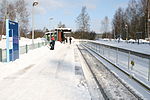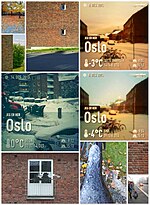Kringsjå (station)
1934 establishments in NorwayOslo Metro stations in OsloOslo Metro stations located above groundRailway stations opened in 1934

Kringsjå is a rapid transit station of the Oslo Metro's Sognsvann Line. It is situated Kringsjå neighborhood of the Oslo, Norway, borough of Nordre Aker. Located 8.4 kilometers (5.2 mi) from Stortinget, the station is served by Line 5 of the metro every fifteen minutes. Travel time to Stortinget is fifteen minutes. The station opened on 10 October 1934 at the same times as the rest of the Sognsvann Line. The station received a major upgrade in 1993, in which it received longer platforms and an overpass. The new station was designed by Arne Henriksen. Among the most used stations west of the city center, it derives its high ridership from two student dormitory complexes.
Excerpt from the Wikipedia article Kringsjå (station) (License: CC BY-SA 3.0, Authors, Images).Kringsjå (station)
Minister Ditleffs vei, Oslo Nordre Aker
Geographical coordinates (GPS) Address Nearby Places Show on map
Geographical coordinates (GPS)
| Latitude | Longitude |
|---|---|
| N 59.963611111111 ° | E 10.734722222222 ° |
Address
Kringsjå
Minister Ditleffs vei
0862 Oslo, Nordre Aker
Norway
Open on Google Maps










